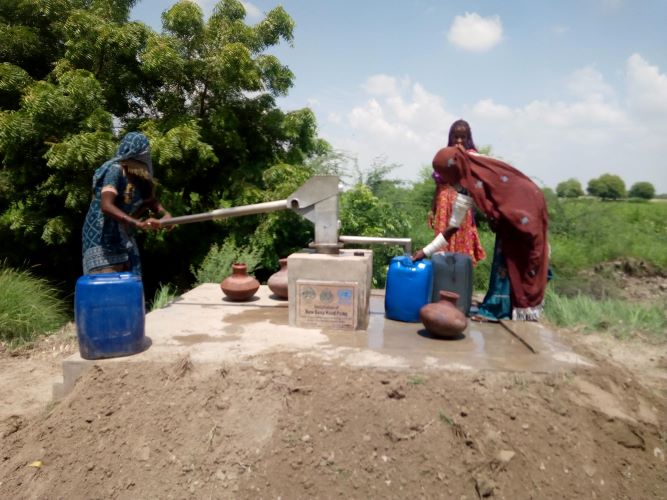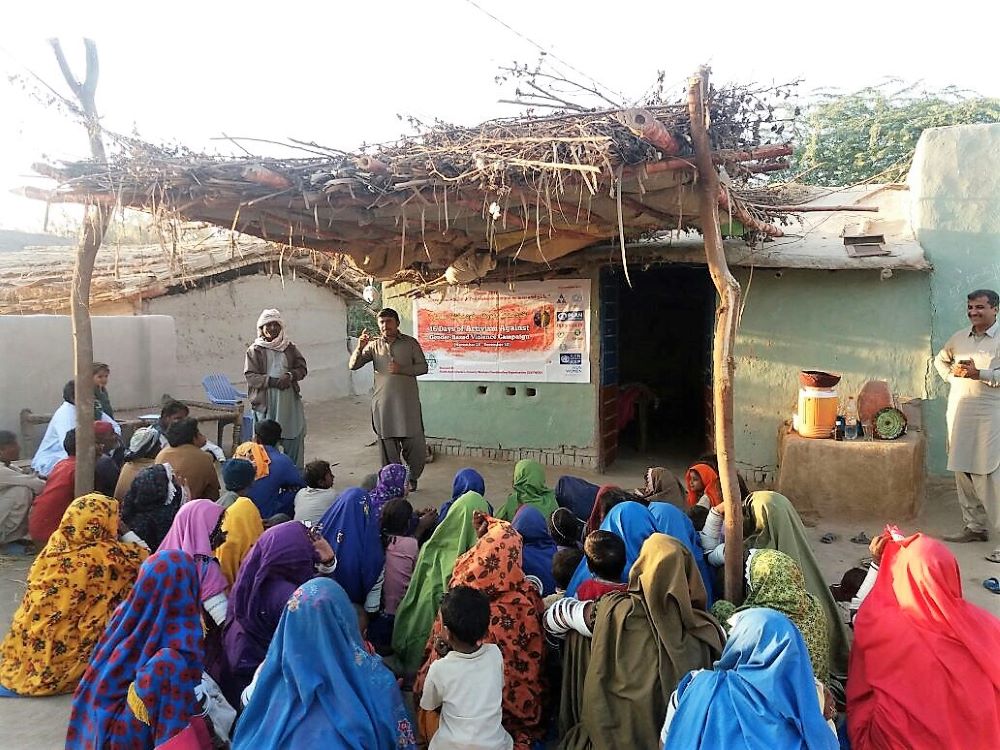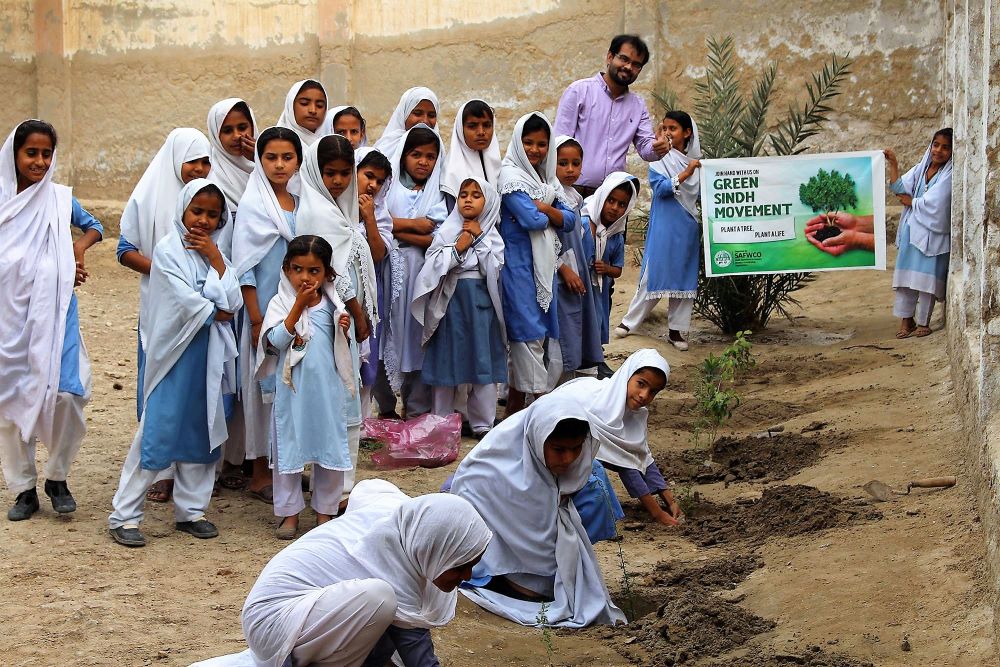
Observations on evolution, growth, and transformation of a Sindh-based NGO
Zaffar Junejo
In a world where organizations, like human beings, are born, influence their surroundings, follow their practices, and eventually fade into obscurity, there are exceptional entities that defy this universal life cycle. Safwco, the Sindh Agricultural and Forestry Workers Coordinating Organization, stands as a shining example of an organization that has not only defied this mortality but has thrived for 25 years.
Safwco’s journey has been one of evolution, growth, and transformation, as it has provided outstanding services in the realms of social development, enterprise development, and financial access to the impoverished population in rural Sindh, Pakistan. What factors have contributed to Safwco’s sustained success? This is the question that beckons us to explore and learn from their remarkable journey. To understand the reasons behind Safwco’s resilience and triumph, I turned to the rich tapestry of development literature and drew inspiration from the wisdom of Edgar Schein’s seminal work, “Organizational Culture and Leadership.” Schein’s insights underline the primary requisites for the success of any organization: shared understandings and assumptions, the ability to adapt and respond to external forces, and the critical importance of internal integration. Equally significant is the cultivation of a polychromic culture that values relationships and collaboration over short-term productivity.

In my quest for insights into Safwco’s success, I had the privilege of engaging in a conversation with Mr. Suleman Abro, the Founder and President of Safwco. Mr. Abro emphasized the inevitability of change, a phenomenon that affects organizations of all shapes, sizes, and ages. Whether initiated internally or driven by external factors, change often ushers in a wave of uncertainty that compels teams to confront the unknown. This very discomfort with the unfamiliar serves as the catalyst for deeper introspection, ultimately leading to the realization that avoiding reality would be perilous.
Mr. Abro described two primary types of change scenarios. The first involves a situation that compels staff and teams to become more sensitive to learning and to address their areas of incompetence. In this scenario, the discomfort serves as a catalyst for improvement. The second, more serious type of change is one driven by survival instincts. It forces an organization to confront the harsh realities it faces, as evading these challenges would be tantamount to self-destruction. In such dire circumstances, effective leaders respond by prioritizing tasks, reshuffling teams, forming task forces, and even introducing new organizational structures, from roles and positions to physical spaces and partitions. Moreover, they confront conflicts within the organization head-on. Mr. Abro went on to highlight that Safwco has traversed both of these types of change scenarios in its journey, underlining its resilience and adaptability as a key to its success. The organization’s ability to embrace these challenges has enabled it to navigate numerous transformations and continue its trajectory of growth and accomplishment.
At the heart of Safwco’s enduring success are the pillars of shared understandings and assumptions, adaptability in the face of external challenges, internal integration, and a polychromic culture that prioritizes relationships. Mr. Suleman Abro’s leadership and his proactive approach to change management have played a pivotal role in Safwco’s expansion and evolution. Indeed, Safwco’s story is not just about the organization; it is about the founder. The vision of any organization is an extension of the vision of its founder. However, the founder’s vision is also molded by the immediate environment and the circle of influence in which they operate. In the case of Mr. Suleman Abro, his ideas were influenced by luminaries such as Omer Asghar Khan, Muhammad Tahseen, Karamat Ali, Suleman Shaikh, and Muneer Chandio. While these influencers shaped his thinking, the pattern and realization of his vision were uniquely his own, rooted in a commitment to addressing the social and development challenges of his region. The transformation of a village-based intervention into a company, particularly engaged in microfinance, might appear as a dramatic shift. However, when delving into Safwco’s digital archive, one can trace the various statements, news reports, and press releases that have documented this journey. It’s a story of adaptation and evolution.

A significant chapter in Safwco’s evolution is the establishment of Safwco Support Foundation (SSF), a newly founded company registered under Section 42 of the Companies Ordinance 1984. SSF has its origins in Safwco, a non-governmental and not-for-profit organization established in 1986 and registered in 1993 under the Societies Act XXI of 1860. Over the last thirteen years, SSF has undergone a transformative process, demonstrating how a blend of service delivery and advocacy can lead to financial sustainability at the operational level. It has established strategic collaborations with client communities and public sector organizations, gradually morphing into a for-profit microfinance subsidiary company since August 2022. SSF now operates in both rural and urban areas of Sindh, Pakistan, with a specific focus on empowering women entrepreneurs, facilitating access to finance, enhancing skills for business growth, establishing rural Women Chambers of Agriculture and Commerce, and implementing grant projects to benefit socially marginalized segments of society.
The most pressing question I sought to answer was how this transition took place and what role leadership, from the founder to section heads, played in this significant shift. In my consultations with Suleman Abro and the section heads of this newly formed organization, a diverse set of experiences emerged. It became clear that the transition from a not-for-profit to a for-profit entity was not a straightforward decision or process. One section head aptly characterized it as “forget one vision and embrace another.” The transition required a shift in the organizational culture from one deeply rooted in a development ethos to a for-profit mindset. Emotions ran high among the staff, who had been trained, motivated, and steeped in the development culture, only to find themselves thrust into a new and unfamiliar landscape of for-profit operations. The need for adaptation was acute, and the introduction of new staff further compounded the challenge of managing diversity. At the core of this transition was the role of leadership. It was their strength that enabled the management of continuous development, and it was their ability to learn and unlearn that played a pivotal role in guiding the organization through this transformative journey.
The key takeaway from my discussions was that leadership in this transition was defined by a continuous learning and unlearning process. Leaders who invest in their education, remain open to their clients and resource providers, and acquire the necessary skills to navigate the ever-changing landscape of the organization are the ones who will thrive in a dynamic and uncertain environment. One section head summed up the leader’s role in the transition succinctly: “It is their learning and de-learning ability that allows them to manage change and handle the transition effectively.”
 As a testament to Safwco’s commitment to inclusivity and empowerment, the organization recently launched the First Women Exclusive Branch. The aim is to reduce the gender gap and provide financial services on an equal footing. In this new venture, all staff members and clients are women. This innovative endeavor marks a new frontier and requires a fresh set of skills and leadership. It may be said that Safwco’s journey and offerings serve as an exemplary learning model for development practitioners. Its story is one of resilience, adaptability, and visionary leadership. Safwco’s ability to navigate change, its commitment to serving marginalized communities, and its transformative journey from a not-for-profit to a for-profit entity offer valuable insights and inspiration for organizations and practitioners in the field of development and social change. The organization’s remarkable 25-year journey continues to inspire and guide those dedicated to making a lasting impact in the realm of development.
As a testament to Safwco’s commitment to inclusivity and empowerment, the organization recently launched the First Women Exclusive Branch. The aim is to reduce the gender gap and provide financial services on an equal footing. In this new venture, all staff members and clients are women. This innovative endeavor marks a new frontier and requires a fresh set of skills and leadership. It may be said that Safwco’s journey and offerings serve as an exemplary learning model for development practitioners. Its story is one of resilience, adaptability, and visionary leadership. Safwco’s ability to navigate change, its commitment to serving marginalized communities, and its transformative journey from a not-for-profit to a for-profit entity offer valuable insights and inspiration for organizations and practitioners in the field of development and social change. The organization’s remarkable 25-year journey continues to inspire and guide those dedicated to making a lasting impact in the realm of development.
The question of how leaders should communicate change to their staff members is indeed a crucial aspect of any organizational transition. According to Mr. Suleman Abro, it is not a straightforward task and comes with inherent risks. However, effective communication is a key factor in facilitating a smooth transition. Mr. Abro emphasizes the importance of clarity and honesty when communicating change. Leaders should be transparent about the reasons behind the change, the expected outcomes, and how it will impact the organization and its members. Hiding information or talking down to team members can erode trust and lead to resistance. One essential aspect of communication is sharing with the staff what the change will bring for them, both in terms of their careers and financial benefits. This means setting clear expectations and communicating the envisaged roles. Staff members need to know what skills and roles are required in the new environment. It’s about providing a roadmap for their personal and professional growth within the changing organization. Furthermore, leaders should foster a culture of open and two-way communication. Secrecy and making tall claims should be avoided. Instead, leaders should provide statements of facts, coupled with encouragement and a futuristic tone. This approach not only helps initiate the transition but also manages the change more effectively.
Suleman Abro, summarized that effective communication during a period of change involves clarity, honesty, transparency, and setting clear expectations for staff members. It’s about providing them with the information and support they need to navigate the transition successfully. Open and two-way communication fosters trust and ensures that everyone is on the same page, working together towards a common goal. I believe, Safwco’s long struggle inspires young professionals to follow it, and create their own space in the development world.
_____________
 Dr. Zaffar Junejo is a historian and a writer, having earned Doctorate from the Department of History University of Malaya, Malaysia. Presently, Mr. Junejo is associated with the European University Institute, Florence, Italy. Apart from scholarly contribution, he also writes for popular media. He could be accessed at: Email junejozi@gmail.com, Cell/WhatsApp +92 334 045 5333 Skype Zaffar.Junejo Facebook facebook.com/zaffar.junejo
Dr. Zaffar Junejo is a historian and a writer, having earned Doctorate from the Department of History University of Malaya, Malaysia. Presently, Mr. Junejo is associated with the European University Institute, Florence, Italy. Apart from scholarly contribution, he also writes for popular media. He could be accessed at: Email junejozi@gmail.com, Cell/WhatsApp +92 334 045 5333 Skype Zaffar.Junejo Facebook facebook.com/zaffar.junejo